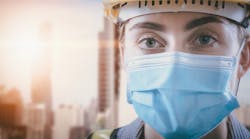So much can change in a year. Last year’s National Safety Survey examined the difference in titles and responsibilities safety professionals have. This year, the dynamics of health and safety within an organization have rapidly evolved since the novel coronavirus has brought illness prevention to the forefront of every conversation.
The year 2020 has brought about an unprecedented set of challenges to the safety industry. The COVID-19 pandemic has required professionals to focus their efforts on illness prevention to ensure business continuity while balancing ongoing “traditional” tasks.
The future of safety profession is evolving, and national elections are right around the corner. Each year, EHS Today surveys its audience of senior safety leaders on what they see as the biggest obstacles facing the industry today, and what they’re doing to overcome them.
This year’s survey was unique as it was completed in the midst of the COVID-19 pandemic. Hundreds of respondents told EHS Today about what drives their passion as leaders and how government officials can support their efforts to keep American workers safe.
Stumbling Blocks
Identifying the biggest challenge that faces safety professionals today is like asking a world-class safety leader if it’s possible to only focus on one key performance indicator (KPI). The industry is responsible for myriad of tasks that require working with multiple stakeholders throughout the organization from the C-suite to human resources to operations.
Respondents to this year’s survey indicated a slight shift to areas other than traditional safety (86%) at their organizations, down from 92% in 2019. As the pandemic puts occupational health in the spotlight, safety professionals indicate that 86% of their employers prioritize support for safety, which is unchanged year-over-year.
When asked if their employer prioritizes safety over production or other business demands, 74% of respondents said that is the case, down 1% from 2019’s numbers. Organizational support can be evidenced in many ways, most notably through budget.Here is what the respondents had to say about the evolving economic situation and budgetary concerns impact a company’s bottom line:
- Due to limited money after the 2008 recession, the newly developing paradigm to focus on what actually causes risk and new ideas to solve them shifted back to a more regulatory mental framework. “Lean and mean” in the long run is counterproductive in many relationships. Also, bean counting i.e., do more inspections, but don’t spend the time on constructive compliance and education, does not empower small businesses to make the needed changes.
- The state of the industry is good with many competent and caring EH&S professionals who want to ensure they contribute to a safe and healthy workplace. The regulatory environment is chaotic and the government needs to learn that regulations do help in many situations and are necessary to keep organization’s honest. Our government’s current approach to regulations is not helping the working person and needs to change.
- There are higher expectations with limited resources (more output with limited human resources and budget).
Regulatory Agencies and the Pandemic
Safety professionals looking for regulatory guidance showed satisfaction with both state and federal efforts. As the 2020 national election approaches, many are looking for a candidate who will support compliance efforts. Here is what respondents had to say about their ideal officials:
• A little empathy and compassion from our leadership is needed and always welcome. Candidates need to communicate the need for the strong balance of safety in the workplace during the pandemic with the need to get back to business and restart the economy. Bottom line: We need some real leadership.
• Addressing health care and emergency health care systems should be a priority. When the pandemic arrived, the country’s system was unable to handle the influx and was ill-prepared for the sheer number of cases. The inability to procure critical PPE also compromised our ability to manage the pandemic. In addition to healthcare improvements, more funding should be directed to OSHA/NIOSH and the CDC for research and rapid deployment preparations in the event of another pandemic.
• Candidates need to ensure that the Chemical Safety Board is recognized and continue to fund this important organization. They also need to ensure that the safety and health of the American worker continue to be protected and supported by not cutting funding to important environmental safety and health organizations.Do you feel like OSHA has done an effective job during this pandemic?
The safety professional’s role is becoming more complex each and every day, but with peer-to-peer input such as the National Safety Survey available, the industry is able to keep employees and workplace safe as the public health crisis continues into 2021. EHS Today thanks everyone who took the time to provide a detailed outlook for safety professionals to make actionable decisions.






